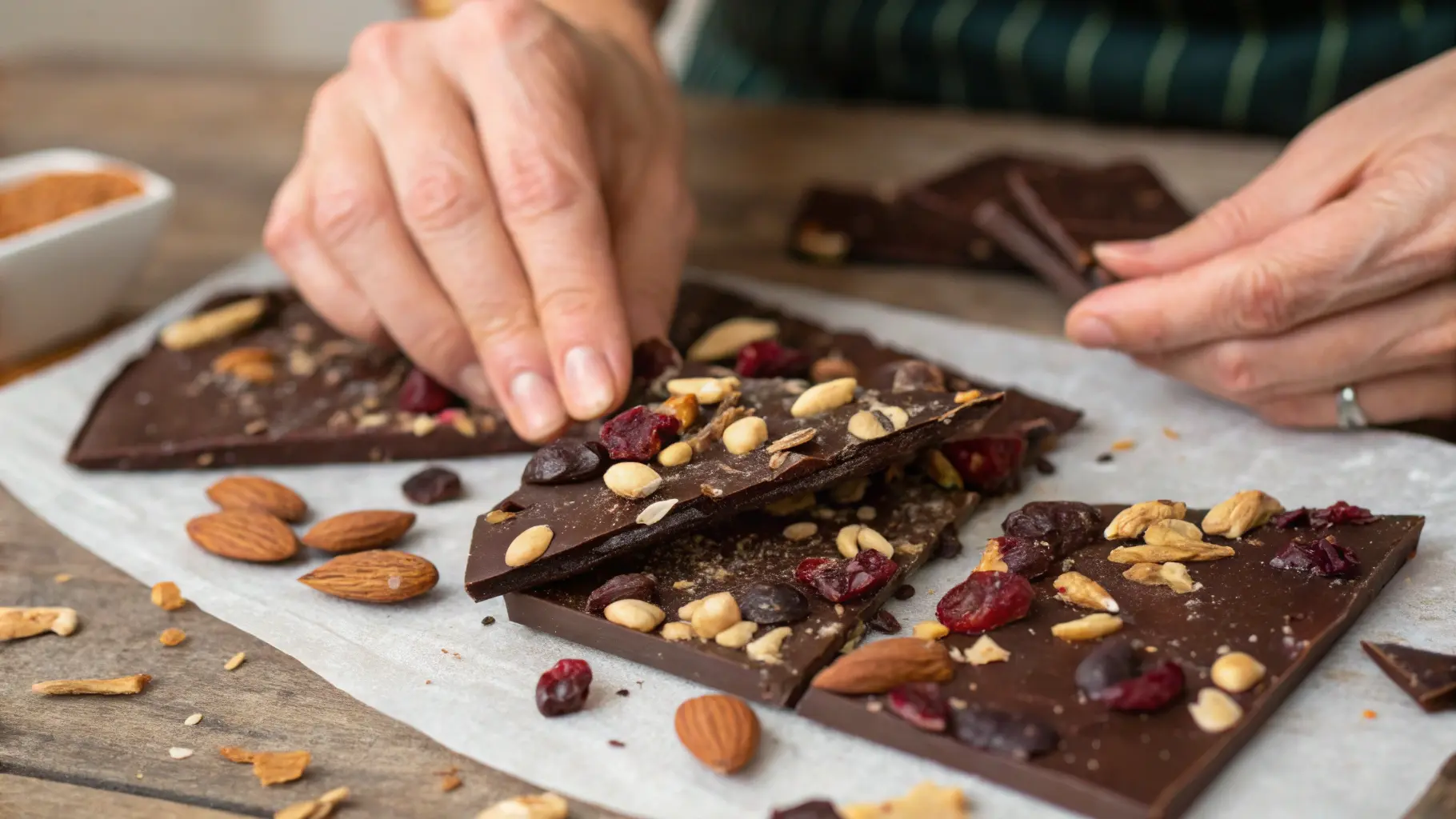If you’re searching for a quick, healthy, and delightfully crunchy dessert, look no further than Coconut Almond Chocolate Bark. This no-bake treat is packed with crunchy almonds, toasted coconut, and rich, melt-in-your-mouth chocolate. Best of all? It’s alcohol-free, gelatin-free, and completely pork-free—making it a go-to option for clean eaters, halal and kosher followers, and everyone in between. But first, let’s break down what makes this sweet snack so irresistible—and surprisingly nutritious.
Why Coconut Almond Chocolate Bark is More Than Just a Treat
It’s tempting to think of bark as just “dessert.” But thanks to its base of real food ingredients, this chocolate bark actually delivers several health benefits:
-
Dark chocolate is packed with flavonoids, known for their antioxidant power. It’s been linked to improved brain function, reduced inflammation, and better heart health.
-
Almonds are a rich source of monounsaturated fats, protein, fiber, and vitamin E. They’re also known for their role in lowering cholesterol and keeping your skin glowing.
-
Coconut adds natural sweetness and a subtle chew. Plus, its medium-chain triglycerides (MCTs) provide quick-burning energy and support metabolism.
Ingredients Breakdown: Picking the Best for Coconut Almond Chocolate Bark
The ingredients make or break this bark—literally and flavor-wise. So, here’s what to use (and what to avoid):
-
Chocolate: Opt for dark chocolate (70% or more cocoa). For dairy-free or vegan options, use cocoa butter-based chocolate without milk solids.
-
Coconut: Choose unsweetened shredded coconut or toast it yourself for a nutty crunch.
-
Almonds: Toasted almonds offer the best crunch and flavor. You can chop them or leave them whole.
-
Optional extras: A sprinkle of sea salt, a drizzle of maple syrup, or even a pinch of cinnamon for warmth.
How to Make Coconut Almond Chocolate Bark: Step-by-Step
Let’s get to the fun part! This recipe requires no oven, no special tools—just a bowl, a tray, and a bit of fridge space.
Ingredients:
-
2 cups dark chocolate chips or a chopped bar
-
1 cup toasted almonds (whole or chopped)
-
1 cup toasted shredded coconut
-
Sea salt (optional)

Instructions:
-
Melt the chocolate using a double boiler or microwave. If using the microwave, stir every 20 seconds to avoid burning.
-
Spread the melted chocolate on a parchment-lined baking tray. Aim for a ¼ inch thickness.
-
Sprinkle the almonds and coconut evenly on top.
-
Lightly press the toppings into the chocolate with a spatula or spoon.
-
Chill in the fridge for 30–45 minutes until solid.
-
Break into rustic pieces and serve or store.
Variations: Make It Your Own
There’s no one right way to enjoy Coconut Almond Chocolate Bark. Try customizing with:
🥜 Other nuts: pistachios, cashews, or hazelnuts
🍓 Dried fruit: cranberries, apricots, or raisins
🍫 Different chocolate: white, milk, or even ruby chocolate
🌱 Spices: cinnamon, cardamom, or chili flakes
🍯 Sweeteners: monk fruit, stevia, or agave
Want to add a fruity twist? You can blend in dried strawberries or even a touch of crushed cookies for a dessert fusion.
Serving Coconut Almond Chocolate Bark: Perfect for Any Occasion
This bark isn’t just tasty—it’s versatile.
-
Serve as a midday snack or healthy dessert
-
Wrap pieces in wax paper and gift them during Eid, Ramadan, Christmas, or birthdays
-
Add to a dessert board or pair with herbal tea
Storage & Shelf Life Tips
-
Keep in an airtight container in the fridge for up to 3 weeks
-
For longer storage, freeze in layers with parchment between pieces
-
Avoid leaving it out too long in warm environments—it melts easily!
Troubleshooting Common Bark Problems
Even simple recipes have their quirks. Here’s how to fix the most common issues:
-
Chocolate won’t melt? Add a tiny bit of coconut oil and stir gently.
-
Toppings not sticking? Press them in gently before chilling.
-
Too sweet or hard? Use darker chocolate or reduce added sweeteners.
Is Coconut Almond Chocolate Bark Actually Healthy?
Great question! While it’s still a treat, it can be healthier than processed sweets:
-
A typical serving (about 2 pieces) delivers antioxidants, healthy fats, and fiber.
-
Homemade versions are free from additives, preservatives, and unnecessary sugar.
-
Skip or adjust the sweeteners for a keto or low-carb version.
So yes—it’s a smarter indulgence when portioned right.
FAQs: People Also Ask About Coconut Almond Chocolate Bark
Because Coconut Almond Chocolate Bark is such a flexible and beginner-friendly recipe, it’s no surprise that people have questions before diving in. Let’s explore the most common ones and clear up any confusion!
1. Can I add coconut oil to the bark?
Yes—absolutely! Adding a teaspoon of coconut oil to your melted chocolate can:
-
Create a glossier, smoother finish
-
Help the chocolate melt more evenly
-
Add a subtle coconut aroma that ties in beautifully with the shredded coconut
However, keep in mind that adding too much coconut oil can make the bark softer at room temperature, so don’t overdo it. A little goes a long way!
2. What type of chocolate should I use?
The best chocolate for bark is dark chocolate with at least 70% cocoa content. Here’s why:
-
It melts smoothly
-
It’s rich in antioxidants
-
It holds its shape and snaps nicely when chilled
If you’re vegan or dairy-free, look for chocolates made without milk solids or butterfat. Many brands now offer plant-based options that still taste decadent.
💡 Tip: Avoid chocolate chips if possible, as they often contain stabilizers that prevent smooth melting. Use chopped chocolate bars instead for the best results.
3. Is almond bark the same as chocolate bark?
Not at all. Despite the similar name, almond bark is not real chocolate. It’s typically made from:
-
Hydrogenated oils
-
Sugar
-
Artificial flavoring
Almond bark is often used for candy coating, but it lacks the richness and depth of real chocolate. For a healthier, more flavorful treat, stick with high-quality dark chocolate for your coconut almond bark.
4. Can I make this without added sugar?
Definitely! In fact, this is one of the best things about homemade bark—it’s totally customizable.
Here are your sugar-free options:
-
Use sugar-free dark chocolate sweetened with stevia or erythritol
-
Try natural sweeteners like monk fruit or coconut sugar
-
Skip added sweeteners altogether if your chocolate is already sweetened
This makes your bark a perfect fit for keto, low-carb, or diabetic-friendly diets. Just be sure to read labels carefully—many commercial sugar-free chocolates contain sugar alcohols that some people prefer to avoid.
5. How do I keep it from melting at room temperature?
Chocolate bark is best kept cool and dry. Here’s how to prevent unwanted melting:
-
Use chocolate with a high cocoa percentage—it has less sugar and more fat, which helps it stay solid longer
-
Add a small amount of coconut oil (but not too much!)
-
Store in the fridge or a cool pantry away from sunlight
In warmer climates or during summer, it’s safer to store your bark in the fridge or even freeze it for extra firmness. Just remember to let it sit out a few minutes before serving to avoid that brittle, just-frozen texture.
6. Can I use desiccated coconut instead of shredded coconut?
Yes, you can—but there are a few things to keep in mind.
-
Desiccated coconut is much finer and drier than shredded coconut
-
It may absorb more moisture from the chocolate, slightly changing the texture
-
It doesn’t provide the same visual appeal or chew factor
If possible, opt for shredded or flaked coconut, especially if you’re toasting it. The larger pieces toast more evenly and add a beautiful crunch and golden color to your bark.
Bonus Tip: Can I freeze Coconut Almond Chocolate Bark?
Yes! In fact, freezing is one of the best ways to extend shelf life without compromising taste or texture.
-
Freeze in airtight containers or freezer-safe bags
-
Separate layers with parchment paper
-
Thaw in the fridge or on the counter for about 10 minutes before enjoying
This is perfect if you’re meal prepping snacks or making ahead for gifting during holidays like Eid, Christmas, or Mother’s Day.
Final Thoughts: Why You Need to Try Coconut Almond Chocolate Bark
So, if you’re on the hunt for a dessert that’s both satisfying and clean, Coconut Almond Chocolate Bark is exactly what you need. Whether you’re craving something sweet after dinner, looking for a nutritious midday snack, or need a quick and beautiful homemade gift, this bark truly delivers.
Creativity in the kitchen doesn’t stop here. If you’re drawn to exotic flavor pairings like this bark, you’ll love experimenting with recipes like Rose Pistachio Cheesecake Ice Cream—a floral twist on traditional indulgence.
Here’s why you’ll fall in love with it:
🌱 Naturally wholesome – No artificial additives, preservatives, or mystery ingredients.
🕒 Time-saving – Ready in under 30 minutes with no baking required.
🧘🏽♀️ Diet-flexible – Easily fits into vegan, dairy-free, halal, kosher, gluten-free, and even low-carb lifestyles.
🎁 Gifting gold – Wrap it up for holidays, birthdays, or Ramadan treats. It’s thoughtful, beautiful, and homemade.
💡 Creative and customizable – Add your own spin with dried fruits, spices, or alternative chocolates to create a flavor combination that’s uniquely yours.
In a world full of store-bought snacks and overly processed sweets, it feels refreshing to enjoy something that’s simple, homemade, and intentional. Each bite brings together silky chocolate, crunchy roasted almonds, and the nutty sweetness of coconut—a trio that’s hard to beat.
So go ahead—melt, spread, sprinkle, chill, break, and enjoy. And when you do, snap a photo, share it with your community, and inspire others to try it too. Sometimes, the best things in life really are this simple.

Coconut Almond Chocolate Bark
This no-bake, gluten-free, and dairy-optional treat combines rich dark chocolate, toasted coconut, and roasted almonds for a crunchy, satisfying bark that’s perfect for snacking or gifting.
- Total Time: 40–50 minutes (including chill time)
- Yield: 10–12 servings (about 20–24 small bark pieces) 1x
Ingredients
- 2 cups dark chocolate (chips or chopped bar, 70%+)
- 1 cup toasted almonds (whole or chopped)
- 1 cup unsweetened shredded coconut (toasted)
- Optional: 1 tsp coconut oil (for a glossy finish)
- Optional: sea salt flakes or maple syrup drizzle
Instructions
- Melt chocolate using a microwave or double boiler.
- Stir in coconut oil if using.
- Spread chocolate onto a parchment-lined tray.
- Sprinkle almonds and shredded coconut evenly on top.
- Lightly press toppings into the chocolate.
- Chill in refrigerator for 30–45 minutes until firm.
- Break into rustic pieces and enjoy or store.
- Prep Time: 10 minutes
- Cook Time: 0 minutes
- Category: Dessert, Snack, Homemade Gift
- Method: No-Bake, Chilling
- Cuisine: American, Fusion
- Diet: Gluten Free
Keywords: Coconut almond chocolate bark, healthy chocolate snack, no bake dessert, vegan chocolate bark, gluten free chocolate bark



